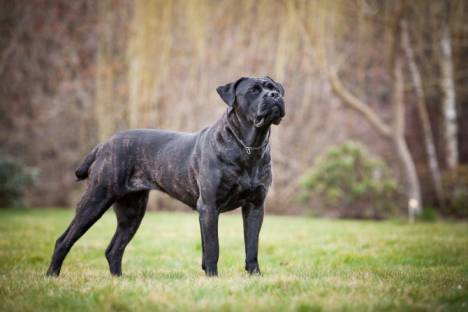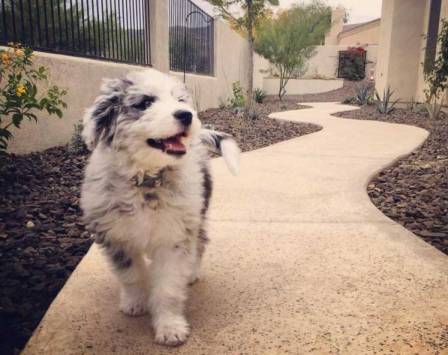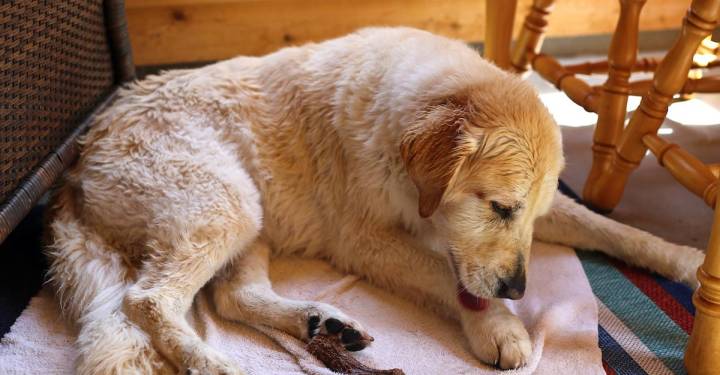Has your dog developed calluses on their paw pads? Have you heard about calluses before and are wondering what they are? We all want the best for our furry friends and their health is important to us. That is why it is essential to learn about paw pad calluses, how you can treat them and ways to prevent them from returning. So, let’s get started and take a look at dog paw pad calluses.
Connect with a verified veterinarian in minutes. Licensed vets are available 24/7 to answer your questions. No need to worry about your furry family member.
What are Dog Paw Pad Calluses and Why Do They Develop?
First of all, it is important to understand what exactly a callus is so that you are able to spot them on your dog’s paw pads. Essentially, they look like a chunk of dry skin on the paw pads. Think about skin corns or warts. They look different to a cut and they have a rough and firm texture when you touch them. They should not be painful for your pooch to begin with. But they can become worse over time and get infected if you do not treat them or they remain detected. Calluses can actually form on other areas of the body and not just the paw pads. This includes on the elbows and hips; anywhere that your dog rests on during the day.
Calluses on your dog’s paw pads often develop from walking on hard surfaces continuously. They are caused by friction. For example, if you walk your dog on a lot of concrete sidewalks, this can lead to calluses over time on their paw pads. Because the paw pads rub along the concrete, this motion can lead to these chunks of dry and hardened skin to form. It is a way for the paw pad to adapt and dry to prevent this friction. They will start small and get bigger over time. In addition, the weather can play a part in the development of calluses. For example, if they are walking on hot sidewalks without boots, this can thicken the pads. Plus, icy and cold sidewalks can make them worse too. Your dog’s paw pads are sensitive and they can even become infected if you are not careful.
On some occasions, calluses are caused by underlying health conditions. For example, some vitamin deficiencies can cause calluses to appear on your dog’s paw pads. If your dog has them a lot or they keep returning despite your best efforts, it may be time for a trip to the veterinarian. They will be able to examine your pooch and come to a conclusion on why calluses are forming, as well as give you tips on how to rectify the problem.
If you see your pup limping, check your dog’s feet and look for blisters. Long dog walks specifically on hot pavement, rough surfaces or during cold weather could create a medical condition for older dogs. Pet parents can use booties or dog’s pads to address canine distemper. Abrasions and a specific skin condition may require a biopsy from the vet to ensure your pup is not suffering from an undiagnosed autoimmune disease or dvm specifically common in terriers. Keratin can have an effect and a foot pad will certainly addressed crusty or cracked paws.
Dog owners or a groomer often find similar symptoms on a dog’s nose and this can be a side effect of an immune system shutting down or liver disease. Particularly common in golden retrievers and sometimes caused by zinc deficiency, these scrapes can be smoothed by pet owners with paw wax and zinc supplements.
Ways to Remove a Callus from Your Dog’s Paw Pad
If the callus is small and minor, you can remove it on your own at home. There are just a few things you will need first. For your pooch, you will definitely need some tasty treats. This treatment will require them to stay still for a while. So, you want treats on hand to reward them and keep them interested. An impatient dog is going to make this task a lot more difficult. You will also need a handheld pumice stone. You can get these at your local store. Simply look in the cosmetic section. Other things you will need include warm water, a bowl and some Epsom salt and a drying towel. Then you are ready to start.
To begin to remove the callus, you will need to soak your dog’s paw pad in water. You can use a bowl of warm water for this task. It just has to be deep enough to cover your dog’s whole paw. You will need to soak the foot for around five minutes. Of course, if your dog starts to get impatient and wants to move around, this is when you bring in the treats. You can add some Epsom salts to the bowl if the calluses are bad and you want to clean them. This can help to soften the area and clean them of any bacteria. It may also help with any swelling or discomfort in the area. Use a small amount of Epsom salts in the water bowl. Once the five minutes are up, towel dry your dog’s paw pad thoroughly. Get all the water away and pat it gently. Then you want to take the handheld pumice stone and rub it over the top of the callus. Move the pumice stone in one direction. You want to apply a light to medium pressure for around 30 seconds at a time. Your dog may find this uncomfortable, but you will have to get them to stay still to carry out this step. It should not hurt your pooch but they may not like the feeling. Again, treats are always a good way to convince your pooch to stay and reward them for being good.
Removing a callus from your dog’s paw pad should not be painful. The callus should not be infected or cracked before you begin. Your dog might find it an uncomfortable sensation or not like lifting their paw. But if you apply too much pressure and over-rub the area, this could become painful and you want to avoid this. So, make sure that you check the callus regularly. You should be able to see obvious progress when removing the callus. If your dog becomes too impatient, you can always try again tomorrow. Sometimes, it can be a gradual process and if it is the first time you are trying to remove a callus, take your time to get it right. Make sure that you do not wrap your dog’s callus. While this can seem like a good idea at the time, it can actually make it worse. So, unless your veterinarian tells you to, avoid using bandages or socks on the callus.

Review symptoms, medications & behavior to keep your pets healthy with a Vet Online in just minutes.
Ask a Vet Live NowWhen to See the Vet
There are a few reasons why you might have to see a vet. First of all, if you have discovered a callus and it looked cracked or infected, it is best to arrange an appointment with an expert. This might need treatment beyond a pumice stone. For example, if it looks infected, such as with blood or seeping liquid, you should not try to treat the callus on your own at home. A veterinarian will need to examine your dog and take a closer look at what is going on. This can prevent it from getting even worse. If your dog is in pain, a vet will be able to administer the correct pain relief medication. You should never attempt to give your pooch medication you have at home. You do not know whether it is toxic and suitable for consumption for furry friends.
Another reason why you should go to the vet is if you are not confident treating the callus yourself. If you think you are unable to do it, a professional will be able to help you. Perhaps your pup will not stand still or they are acting aggressively when you are trying to rub the callus. A vet will be able to assist you with getting rid of the callus and figure out if there is an underlying issue why they are acting this way.
Tips to Avoid the Growth of Dog Paw Pad Calluses
Of course, everyone wants to make sure that their dog does not get a callus again. The good news is that there are a few things you can do to make sure your pooch has the best chance of avoiding them in the future. Let’s take a look at some things you can do today.
Moisturize the Paw Pads
Let’s not forget that callus is a fancy word for a dry chunk of skin that forms on your dog’s paw pad. This means that you can moisturize it was a paw butter in order to soften the skin. This may provide your dog with some comfort. Once you get rid of the callus, moisturizing the paw pads every day can be a good way of preventing them from returning. It is just what you would do to your own skin if it became dry. When your dog is back from their daily walk, make it a habit to moisturize their paws. This is going to help prevent calluses from returning. This is particularly true if you have been walking on the sidewalk or other hard surfaces. If your dog tries to lick off the moisturizer, you can always slip on a sock over their foot until it tries. Pups cannot resist anything that smells good to eat!
Trim the Nails Regularly
It is best to trim your dog’s nails on a regular basis. Keeping them short will not only feel better for your pooch when they are walking, but it will also prevent some paw pad calluses from developing. As a general tip, your pup’s nails should not touch the ground. If you can hear them on concrete or on a wooden floor, this can be a sign that they are too long. You can use a nail grinder or nail file in order to trim your canine’s nails. Just be careful that you do not cut too close to the quick. This can cause bleeding and discomfort for your pooch. It may be the case that you have to trim their nails over several weeks so that they shorten correctly and to the length that you want. Take your time to ensure your pup does not get hurt in the process. This should prevent calluses returning if this was the cause in the first place.
Avoid Hard Surfaces
If it is possible, try to walk your pooch somewhere that is soft and flat. For example, if you can visit a local park, keep them on the grass and walk them on this softer surface. Try to avoid running with your pooch on concrete or other hard surfaces. This is going to increase the chance of friction and the development of calluses over time. If your dog has had them before, it is likely that they will get them again unless something changes in their daily lives.
Purchase Dog Boots
Not everybody will be able to avoid walking their dog on hard surfaces. For example, you may not live near a park or somewhere else to walk your pooch. Instead, you can purchase dog boots for your furry friend. This is going to create a shield between the ground and your pup’s paw pads. There are different sizes available and they usually stay secure thanks to Velcro straps. Dog boots also save your dog having contact with hot sidewalks during the summer and cold ice during the winter. Choose a pair with padded soles so that are comfortable for your canine. Plus, they are totally cute and everybody will comment on how great they are!
It may take some time for your four-legged friend to get used to wearing dog boots. Try only wearing two at a time so they can get used to how they feel on their feet. It is like they have to learn how to walk all over again! Practice in the house before you head outside. Eventually, they will hardly notice they are there and happily walk around showing off their cool dog boots.
Use Blankets at Home
Dogs can develop calluses in the home, as well as outside. For example, they can develop the elbows and from leaning on hard surfaces for a long time. So, make sure that your home is comfortable for your pooch. Offer them lots of soft and comfortable blankets to lay on. While they may not always take this option, at least you can say you have tried! Once and a while, you can let them sleep on the bed or the sofa so it is a soft surface for them. Perhaps it would be a good excuse to buy a new dog bed too.
Connect with a verified veterinarian in minutes. Licensed vets are available 24/7 to answer your questions. No need to worry about your furry family member.

Kyoko
Kyoko is from a family of 3 and moved to New York with her parents and siblings when she was 13. Kyoko is fond of spending a great amount of time with pets, specifically her beagle Luna and cat Missy. Her boyfriend often complains that she spends too much time giving attention to their animals. Kyoko has written dozens of articles concerning pets and is aiming at owning a pet shop one day!
Review symptoms, medications & behavior to keep your pets healthy with a Vet Online in just minutes.
Ask a Vet Live Now



